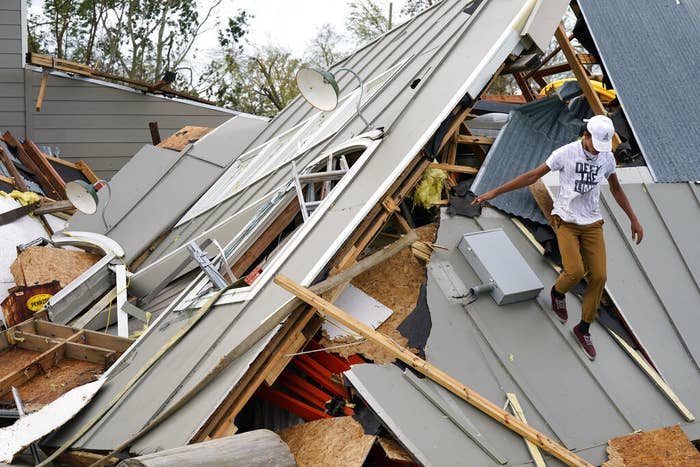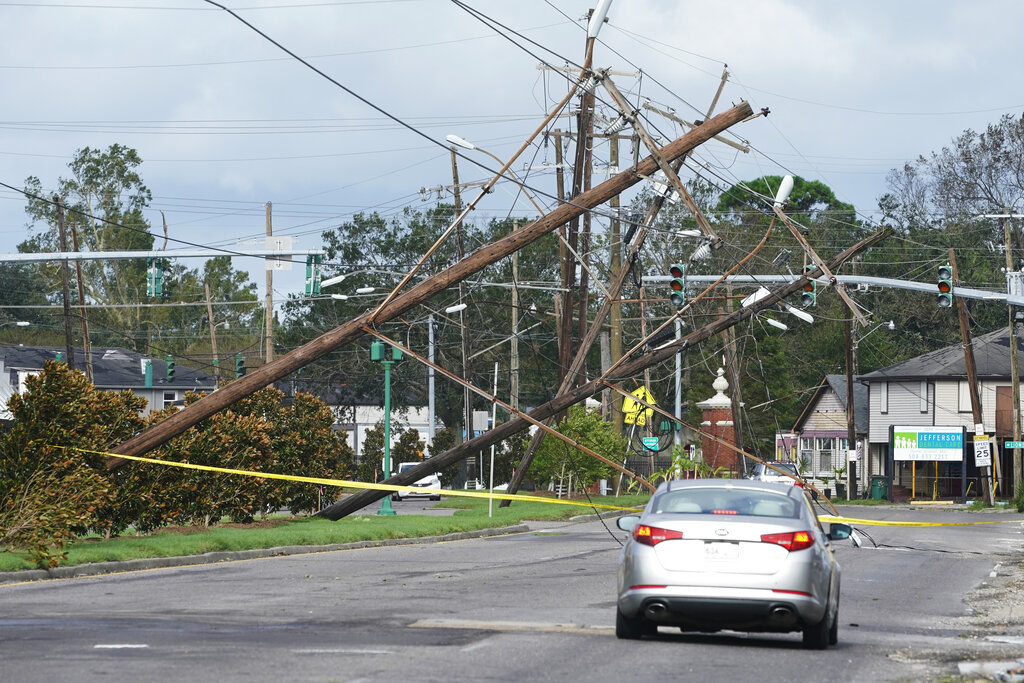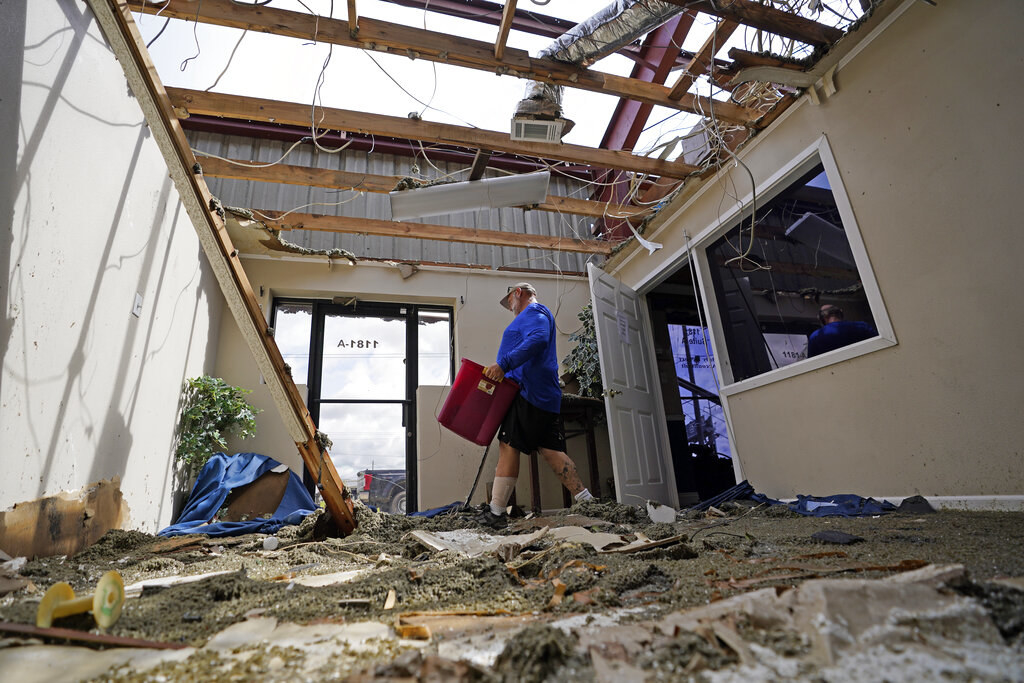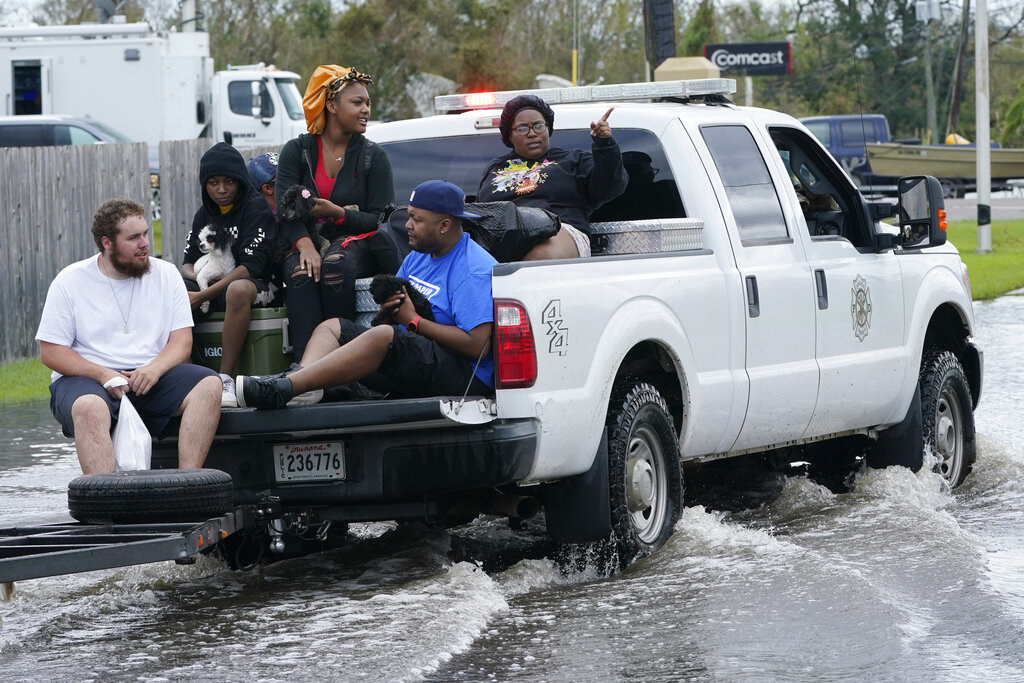
At least two people died as Hurricane Ida slammed Louisiana on Sunday with 150 mph winds, damaging homes and businesses, uprooting trees and power lines, causing 911 outages, and leaving a million people, including all of New Orleans, without power.
Ida weakened to a tropical storm early Monday, and is moving to Mississippi as officials warned of threats from heavy rainfall and flash floods over much of Mississippi, Alabama, and the Western Florida Panhandle, according to the National Hurricane Center. Tornado threats also continued across the central Gulf states.
One person died on Sunday after being possibly injured from a fallen tree at a residence in Ascension Parish, the sheriff's office said. On Monday, the Louisiana Department of Health confirmed a man drowned after attempting to cross flood waters near Interstate 10 in New Orleans.
"I fully expect that the death count will go up considerably throughout the day," Gov. John Bel Edwards told MSNBC on Monday, as search and rescue efforts were underway.
Edwards said the state's levee system performed very well. There were no levee breaches or overtopping within the Greater New Orleans region, the Flood Protection Authority said Monday. That is a stark contrast to Hurricane Katrina 16 years ago, when the levee system failed and flooded large swaths of the city.
However, the storm surge, rain, and winds had "devastating impacts" across southeast Louisiana, Edwards said, adding that water systems were down and "virtually no one has electricity in this part of our state right now."
"We did not have another Katrina," New Orleans Mayor LaToya Cantrell said Monday. "While we held the line, now is not the time for reentry," she warned visitors and evacuated residents.
Officials said that while there was citywide power loss, the levee system ensured that homes and businesses in New Orleans were largely saved from flooding and widespread structural damage. There were also no reports of massive loss of life, the mayor said.
Cantrell said one person died after drowning while driving, but added that official confirmation would come from the coroner's office.
Many 911 call centers throughout Louisiana were down, and before service was fully restored in the city of New Orleans on Monday afternoon, residents with emergencies were asked to go to their nearest fire station or flag down an officer.
More than 1,600 personnel began conducting search and rescue across the state early Monday, Edwards said. The National Guard has deployed over 5,200 personnel to help with rescue and relief efforts in Louisiana, Mississippi, Texas, and Alabama.

The Louisiana State Police warned stranded residents on Monday that "it may be difficult to get help to you for quite some time."
"The full extent of damage is yet to be seen," the agency said in a Facebook post, adding that search and rescue missions will begin once first responders are able to navigate through areas blocked by downed trees and power lines, along with debris and standing water.
The @USCG conducted overflights to assess damages following #HurricaneIda Find out more at our #newsroom https://t.co/KVJkx9pMBv
The entire city of New Orleans lost power on Sunday night because of Ida's "catastrophic damage" to its transmission system, according to Entergy, the main power utility in the city.
Ida damaged all eight transmission lines feeding power to the city, and as of early Monday morning, there were 880,000 power outages around the New Orleans region, with several surrounding parishes also affected, Entergy CEO Deanna Rodriguez said in a press briefing Monday afternoon.
"It will be premature for me to speculate when power will be restored," Rodriguez said.
The company said it will likely take days to determine the extent of the damage to the power grid in the city and "far longer" to restore electrical transmission in the region. Those in the hardest-hit areas could experience power outages for weeks, Entergy said.
One of the reasons New Orleans is without power. This transmission line that runs across the Mississippi River from Avondale to Harahan had a collapsed tower. Lines are literally in the River. #hurricanida #lawx #neworleans
The mayor urged residents and businesses to "share the power you have" with others to recharge their devices while the city's power is still dependent on generators.
As of Monday morning, over 1 million customers across the state were without power, according to PowerOutage.US. Power outages also affected more than 100,000 people in Mississippi.

At least 18 public water systems were experiencing water outages on Monday, affecting more than 312,000 people, according to the Louisiana Department of Health.
"This is going to be a very long ordeal in terms of getting everything cleaned up and repaired," Edwards said Monday, adding that the priority right now was to "be in lifesaving mode."
"The main thing I want to make clear to all of you is we're providing any help that you're going to need," President Joe Biden told Edwards and other state and local officials on Monday.
Biden urged residents to continue to "shelter in place if it's safe for them to do so," adding that 50 shelters have been opened across the Gulf Coast for those who have lost their homes.
The president said that more than 200 generators have been moved the region with FEMA working to send more. He said that while the local electric providers were private, the federal government was "doing all we can to minimize the amount of time it's going to take to get power back up for everyone in the region."

Even as the threat of severe weather had passed New Orleans, authorities warned residents that it was not safe to leave their homes on Monday.
The mayor of the town of Jean Lafitte said that its tidal surge levees had overtopped on Sunday night, leaving up to 200 people in "imminent danger," according to the National Weather Service.
Some residents, trapped in their attics or rooftops, posted their addresses on social media in an attempt to be rescued.
"We know individuals are out there waiting to be rescued," Edwards said, emphasizing that robust search and rescue efforts were ongoing at the federal, state, and local levels.
Jefferson Parish received approximately 200 calls for rescue as people endured "a very, very long night," Cynthia Lee Sheng, president of Jefferson Parish, told Today.
She added that a lot of "frantic" family members hadn't heard from their loved ones through the night as there was no power and communication lines were down.

A mandatory curfew is in effect for all of Jefferson Parish until at least 6 a.m. on Tuesday. Residents were asked to minimize wastewater leaving their homes to avoid overloading the sewer system, with power outages increasing the likelihood of sewerage backups.
Local officials said people in and around Kenner — the largest city in Jefferson Parish — should be prepared to go without water for five days.
In Lafourche Parish, reentry will be delayed for up to a week, maybe longer, as roads were unpassable, the Parish said. Lafourche, which has a population of nearly 98,000, is also under a boil water advisory with many residents without water.
There were reports of damage and loss of power in hospitals that are already struggling with the deluge of COVID-19 patients — with some facilities having to move patients around, and others planning to evacuate dozens of patients to other hospitals.
The White House said that more than 3,600 FEMA employees have been deployed and 17 urban search and rescue teams, along with hundreds of air and ground ambulances, have been staged. FEMA has also deployed more than 3.4 million meals.
This is a breaking news article. Please come back for updates and follow BuzzFeed News on Twitter.
